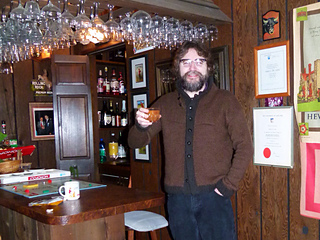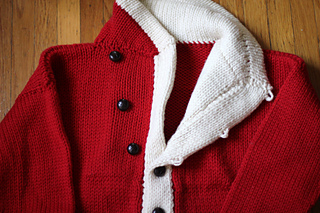patterns > Knit Picks >  Knit Picks website and 1 more...
Knit Picks website and 1 more...
> The Georgia Peach










The Georgia Peach
YARN Knit Picks Swish Bulky, 100% Superwash Merino Wool; 137 yds/100g: Serrano 25572 (MC), 6 (7, 7, 8, 8, 9, 9) skeins, Bare 24389 (CC), 2 (3, 3, 3, 3, 4, 4) skeins.
If you are knitting the men’s size for a very tall man, you may need more yarn to make a longer body.
NEEDLES US Size 9 (5.5 mm): 24” or larger circular (cir), and double pointed needles (dpns) US Size 10 (6 mm): 24” or larger circular (cir), 16” circular, and double pointed needles (dpns). Adjust needle size if necessary to obtain the correct gauge.
NOTIONS Stitch markers, stitch holder or scrap yarn, tapestry needle, ¾” leather buttons: 9 (9, 9, 10, 10, 10, 10)
Ty Cobb, one of baseball’s favorite surly characters and one of the best players in Detroit Tigers history, was nicknamed The Georgia Peach - ironically, of course. Growing up a Tigers fan my brain was filled with Ty Cobb lore early; like how he use to sharpen his cleats so players would learn to get out of his way when he was sliding into second base. I know now there was more of a sinister side to this baseball great, and his faults add depth to his character and interest to his story; strong and uncompromising, hard but respected, born with nothing, and surviving and succeeding with only willpower and talent.
The Georgia Peach is a bulky weight version of the baseball sweater worn by players 100 years ago. Unusual button placement make it unique and keep you very warm while playing an early season baseball game. Customize it to your team’s colors to show your team spirit while waiting for baseball season to start up again all winter long.
Notes: Worked from the bottom up, stitches are held as fronts and backs are completed. Stitches are picked up around armholes and sleeves are worked in the round to the wrist. Stitches are picked up for the collar and short rows are worked for shaping. Stitches are picked up for button bands, and contrasting color inner side panels are seamed to the inside of the sweater.
6338 projects
stashed
3306 times
- First published: February 2013
- Page created: February 13, 2013
- Last updated: April 19, 2025 …
- visits in the last 24 hours
- visitors right now




